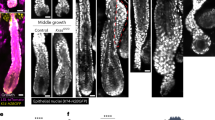Abstract
Calcium ions (Ca2+) and nitric oxide (NO) are key signalling molecules that are implicated in the regulation of numerous cellular processes. Here we show that, in the intact liver, stimulation of endothelial cells by bradykinin coordinates the propagation of vasopressin-dependent intercellular Ca2+ waves across hepatic plates, and markedly increases the frequency of Ca2+ oscillations in individual hepatocytes. Modulation of Ca2+ oscillations by bradykinin is lost following isolation of hepatocytes, but restored in co-cultures of hepatocytes and endothelial cells. The sensitizing effects of bradykinin are mimicked by NO donors and abrogated by NO inhibitors. Thus, crosstalk between NO and Ca2+ signalling pathways through the microvasculature is probably an important mechanism for the coordination of liver function and may have a function in other organs.
This is a preview of subscription content, access via your institution
Access options
Subscribe to this journal
Receive 12 print issues and online access
$209.00 per year
only $17.42 per issue
Buy this article
- Purchase on Springer Link
- Instant access to full article PDF
Prices may be subject to local taxes which are calculated during checkout







Similar content being viewed by others
References
Berridge, M. J. Inositol trisphosphate and calcium signalling. Nature 361, 315–325 (1993).
Taylor, C. W. & Traynor, D. Calcium and inositol trisphosphate receptors. J. Membr. Biol. 145, 109–118 (1995).
Patel, S., Joseph, S. K. & Thomas, A. P. Molecular properties of inositol 1,4,5-trisphosphate receptors. Cell Calcium 25, 247–264 (1999).
Hajnóczky, G., Robb-Gaspers, L. D., Seitz, M. B. & Thomas, A. P. Decoding of cytosolic calcium oscillations in the mitochondria. Cell 82, 415–424 (1995).
Gu, X. & Spitzer, N. C. Distinct aspects of neuronal differentiation encoded by frequency of spontaneous Ca2+ transients. Nature 375, 784–787 (1995).
Dolmetsch, R. E., Xu, K. & Lewis, R. S. Calcium oscillations increase the efficiency and specificity of gene expression. Nature 392, 933–936 (1998).
Li, W.-H., llopis, J., Whitney, M., Zlokarnik, G. & Tsien, R. Y. Cell-permeant caged InsP3 ester shows that Ca2+ spike frequency can optimize gene expression. Nature 392, 936–941 (1998).
Berridge, M. J. Elementary and global aspects of calcium signalling. J. Exp. Biol. 200, 315–319 (1997).
Thomas, A. P., Bird, G. St J., Hajnóczky, G., Robb-Gaspers, L. D. & Putney, J. W. Jr Spatial and temporal aspects of cellular calcium signaling. FASEB J. 10, 1505–1517 (1996).
Sanderson, M. J., Charles, A. C., Boitano, S. & Dirksen, E. R. Mechanisms and function of intercellular calcium signaling. Mol. Cell. Endocrinol. 98, 173–187 (1994).
Moncada, S., Palmer, R. M. J. & Higgs, E. A. Nitric oxide: physiology, pathophysiology, and pharmacology. Pharmacol. Rev. 43, 109–142 (1991).
Bredt, D. S. & Snyder, S. H. Nitric oxide: a physiologic messenger molecule. Annu. Rev. Biochem. 63, 175–195 (1994).
Robb-Gaspers, L. D. & Thomas, A. P. Coordination of Ca2+ signaling by intercellular propagation of Ca2+ waves in the intact liver. J. Biol. Chem. 270, 8102–8107 (1995).
Pearson, J. D. & Gordon, J. L. Vascular endothelial and smooth muscle cells in culture selectively release adenine nucleotides. Nature 281, 384–386 (1979).
Ralevic, V. & Burnstock, G. Receptors for purines and pyrimidines. Pharmacol. Rev. 4, 13–92 (1998).
Dixon, C. J., Woods, N. M., Cuthbertson, K. S. R. & Cobbold, P. H. Evidence for two Ca2+-mobilizing purinoreceptors on rat hepatocytes. Biochem. J. 269, 499–502 (1990).
Rooney, T. A., Joseph, S. K., Queen, C. & Thomas, A. P. Cyclic GMP induces oscillatory calcium signals in rat hepatocytes. J. Biol. Chem. 271, 19817–19825 (1996).
Guihard, G., Combettes, L. & Capiod, T. 3":5"-cyclic guanosine monophosphate (cGMP) potentiates the inositol 1,4,5-trisphosphate-evoked Ca2+ release in guinea-pig hepatocytes. Biochem. J. 318, 849–855 (1996).
Akaike, T. et al. Antagonistic action of imidazolineoxyl N-oxides against endothelium-derived relaxing factor/.NO through a radical reaction. Biochemistry 32, 827–832 (1993).
Robb-Gaspers, L. D. et al. Integrating cytosolic calcium signals into mitochondrial metabolic responses. EMBO J. 17, 4987–5000 (1998).
De Koninck, P. & Schulman, H. Sensitivity of CaM kinase II to the frequency of Ca2+ oscillations. Science 279, 191–192 (1998).
Oancea, E. & Meyer, T. Protein kinase C as a molecular machine for decoding calcium and diacyl glycerol signals. Cell 95, 307–318 (1998).
Leybaert, L., Paemeleire, K., Strahonja, A. & Sanderson, M. J. Inositol-trisphosphate-dependent intercellular calcium signaling in and between astrocytes and endothelial cells. Glia 24, 398–407 (1998).
Patel, S., Santra, M., McQuillan, D. J., Iozzo, R. V. & Thomas, A. P. Decorin activates the epidermal growth factor receptor and elevates cytosolic Ca2+ in A431 carcinoma cells. J. Biol. Chem. 273, 3121–3124 (1998).
Morgan, A. J. & Thomas, A. P. Single cell and subcellular measurement of intracellular Ca2+ concentration ([Ca2+]i). Methods Mol. Biol. 114, 93–123 (1999).
Acknowledgements
We thank A.D. Michel, B.M. Hantash, L.S. Jouaville, W.N. Duran, G.C. Churchill and A. Galione for helpful comments; and M.J. Woolkalis for initial provision of CPAE cells. This work was supported by grants from the NIH (to A.P.T.) and a Wellcome Prize Travel Research Fellowship (to S.P.).
Correspondence and requests for materials should be addressed to A.P.T.
Author information
Authors and Affiliations
Corresponding author
Rights and permissions
About this article
Cite this article
Patel, S., Robb-Gaspers, L., Stellato, K. et al. Coordination of calcium signalling by endothelial-derived nitric oxide in the intact liver. Nat Cell Biol 1, 467–471 (1999). https://doi.org/10.1038/70249
Received:
Revised:
Accepted:
Published:
Issue Date:
DOI: https://doi.org/10.1038/70249
This article is cited by
-
Spontaneous long-range calcium waves in developing butterfly wings
BMC Developmental Biology (2015)
-
Sharing calcium opens new avenues of signalling
Nature Cell Biology (2000)
-
Nitric oxide pumps up calcium signalling
Nature Cell Biology (1999)



